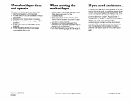
The exhaust duct can
’
be routed up, down,
left, right or straight out
the back of the
washer/dryer. Space
requirements are
provided on Panel G
and on the rear panel
of the washer/dryer.
Use the straightest
path you can to
b
avoid 90” turns.
Maximum length of the exhaust system
depends upon the type of duct used,
number of elbows and the type of
exhaust hood. The maximum length for
both rigid and flexible duct is shown in
the chart.
-
rigid
metal duct
18ft
I
18ft
I
not
recommende
IOfl 9ft
not
recommende
flexible
metal duct
The maximum length usin
s
a 2” x 6’ rectan ular
duct with 2 elbows and a
hood is 8 tt.
-l/2” (TYPE C) ex
7l
aust
For exhaust configurations other than
those listed in the chart, the back
pressure MUST not exceed 0.2 inches
water column at the back of the
washer/dryer. The back pressure should
be checked by a qualified technician.
For exhaust systems not covered by the
exhaust length chart, see Service
Manual, Part No. 603197, available from
your authorized parts distributor.
Service check: The back pressure in any
exhaust system used must not exceed
0.2 inches of water column measured
with an inclined manometer at the
point that the exhaust duct connects to
the dryer.
Exhausting the dryer outside is
recommended. Recessed installation
that is not exhausted outside must use
Exhaust Deflector Kit Part No. 694609,
available from your authorized parts
distributor. See “Recessed and closet
installation instructions,” Panel G, for
unobstructed air opening requirements,
If the washer/dryer is installed in a
confined area such as a bedroom,
bathroom or closet, it must be
exhausted to the outside and provision
must be made for enough air for
ventilation. Check governing codes and
ordinances. Also refer to the “Recessed
and closet installation instructions” on
Panel G.
An exhaust hood
should cap the
exhaust duct to
prevent exhausted
air from returning
into dryer. The
outlet of the
35
12”
mlnlmum
hood must be at least 12 inches from
the ground or any object that may be in
the path of the exhaust.
Four-inch exhaust hood is preferred.
However, a 2-l/2-inch exhaust hood
may be used. A 2-l/2-inch exhaust
hood creates greater back pressure
than other hood types. For permanent
installation, a stationary exhaust system
is required.
Exhausting the dryer
through the side of the
washer/dryer requires
m-l
the use of Side Exhaust
Kit, Part No. 279823,
available from your
authorized parts
distributor. Follow kit
Installation
Instructions for
proper exhaust
installation.
Panel D
Mobile home installation
This washer/dryer is suitable for mobile
home installations. The installation of the
washer/dryer must conform to the
Manufactured Home Construction and
Safety, Title 24 CFR, Part 3280 (formerly
the Federal Standard for Mobile Homes
Construction and Safety, Tile 24. HUD
Part 280, latest edition).
Mobile home exhaust
requirements: The
washer/dryer must
have an outside
exhaust. If the dryer is
exhausted through
the floor and the
area under the
mobile home is
enclosed, the
exhaust system
must terminate
outside the
enclosed area.
tloor enclosed area
Extension beyond the enclosure will
-outside
wall
skirting
prevent lint and moisture buildup under
the mobile home.
Now start...
with washer/dryer in laundry area.
Injury Hazard
More than one person is required to
lift, tilt or move the washer/dryer
because of its weight and size.
Failure to follow this instruction may
result in injury.
rear
l
4
legs
* 1 drain hose clamp
l
1 plastic beaded
strap
l
4 flat, water-
hose washers
l
1 small clamp
3
n
Remove parts from plastic
package. Check that all parts were
included.
4
n
Insert a rear-
leveling leg into the hole
in the rear corner on the
bottom of the
washer/dryer. Push leg in
until it snaps into place.
Do the same same thing
with the other leveling
leg in the other rear corner.
Truck only from rear to prevent product
damage.
1
n
Put on safety glasses and gloves.
2
n
Remove shipping cardboard base.
Numbers
correspond
to steps.
7
n
Place a piece
of cardboard or
hardboard in front of
carton. Now stand the
washer/dryer upright.
Slide washer/dryer
onto cardboard
n
Push up one leg;
check to see that the
other leg goes down.
Check the other leg
the same way. (If legs
do not adjust, repeat
Step 4.)
6
n
With one of the front
legs in hand, check the
ridges for a diamond
marking. That’s how far the
leg is supposed to go into
the hole. Start to screw the
legs into the holes in the
front corners by hand.
Use slip-joint pliers to finish turning the
front legs until you reach the diamond
mark.
Slide washer/dryer onto cardboard or
hardboard before moving across floor to
prevent damage to floor covering.
To orevent oroduct
dahage, do not
remove corner
posts inside the
carton before
cutting.
8
-v
n
With the corner posts in place,
cut the carton down one corner.
Remove carton.











